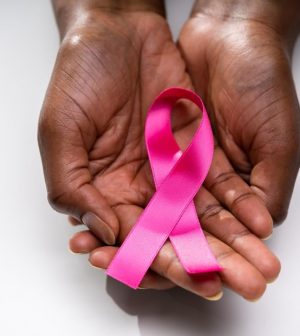- Navigating Your Midlife Crisis: Embracing New Possibilities
- City Raccoons Showing Signs of Domestication
- Mapping the Exposome: Science Broadens Focus to Environmental Disease Triggers
- One Week Less on Social Media Linked to Better Mental Health
- Your Brain Changes in Stages as You Age, Study Finds
- Some Suicide Victims Show No Typical Warning Signs, Study Finds
- ByHeart Formula Faces Lawsuits After Babies Sickened With Botulism
- Switch to Vegan Diet Could Cut Your Greenhouse Gas Emissions in Half
- Regular Bedtime Does Wonders for Blood Pressure
- Dining Alone Could Mean Worse Nutrition for Seniors
Breast, Ovary Removal Can Lengthen Lives of Women With Breast Cancer Genes

It’s a decision no woman wants to have to make, but new research shows that young breast cancer patients with high-risk genes may be able to prevent their cancer from returning if they have their breasts or ovaries removed.
Breast cancer patients aged 40 or younger with BRCA mutations had a 35% lower risk of death and 42% lower risk of cancer recurrence if they underwent a risk-reducing operation to remove their breasts, according to findings presented this week at the San Antonio Breast Cancer Symposium.
Patients also had a 42% lower risk of death and 32% lower risk of recurrence following removal of their ovaries.
“This global study provides the first evidence that risk-reducing surgeries improve survival outcomes among young BRCA-mutation carriers with a prior history of early-onset breast cancer,” said researcher Dr. Matteo Lambertini, an associate professor of medical oncology at the University of Genova-IRCCS Policlinico San Martino Hospital in Italy.
“We believe that our findings are critical for improving the counseling of BRCA-mutation carriers with early-onset breast cancer on cancer-risk management strategies,” Lambertini added in a meeting news release.
It’s been long known that women with BRCA1 and BRCA2 gene mutations are at higher risk for breast and ovarian cancer.
More than 60% of women who inherit a BRCA mutation will develop breast cancer in their lifetimes, according to the National Cancer Institute (NCI).
Likewise, as many as 58% of women with a BRCA1 mutation and 29% of women with a BRCA2 mutation will develop ovarian cancer, the NCI says.
One strategy to lower these women’s risk of cancer is to remove their “at-risk” tissue – that is, to remove their breasts or ovaries.
This strategy has been shown to help reduce risk in women with BRCA mutations who haven’t had cancer, but its effectiveness hasn’t been tested in young women who’ve already developed breast cancer, Lambertini said.
The negative effects also must be considered, particularly when it comes to ovary removal, Lambertini noted. Ovary removal leads to infertility and early menopause.
“Considering the unique traits and needs of this younger population, and their high risk for secondary malignancies, it is critical to understand how risk-reducing surgeries affect patient outcomes, so that the risks and benefits of these procedures can be carefully weighed,” Lambertini said.
For the new study, researchers analyzed data on nearly 5,300 breast cancer patients with BRCA mutations treated at 109 hospitals across five continents. The women were all diagnosed with breast cancer at age 40 or younger between 2000 and 2020.
Among those patients, nearly 3,900 underwent at least one risk-reducing surgery, including around more than 1,800 who had both their breasts and ovaries removed, researchers said.
Results showed that women with BRCA1 mutations benefitted more than those with BRCA2 mutations, with their risk of death reduced by 56% compared with 15%.
Because these findings were presented at a medical meeting, they should be considered preliminary until published in a peer-reviewed journal.
More information
The National Cancer Institute has more on BRCA mutations and cancer.
SOURCE: San Antonio Breast Cancer Symposium, news release, Dec. 11, 2024
Source: HealthDay
Copyright © 2025 HealthDay. All rights reserved.










